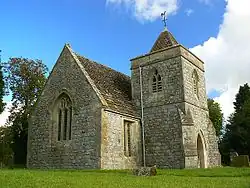St Nicholas's Church, Berwick Bassett
St Nicholas's Church in Berwick Bassett, Wiltshire, England dates from the early 13th century.[2] It is recorded in the National Heritage List for England as a Grade II* listed building,[1] and is now a redundant church in the care of the Churches Conservation Trust.[3] It was declared redundant in 1972,[4] and was vested in the Trust the next year.[5][6] Services continue to be held at the church a few times a year.[7]
| St Nicholas's Church | |
|---|---|
 | |
| Location | Berwick Bassett, Wiltshire England |
| Coordinates | 51°27′39″N 1°51′35″W |
| Built | 15th century |
Listed Building – Grade II* | |
| Designated | 27 February 1958[1] |
| Reference no. | 1365565 |
 Location of St Nicholas's Church in Wiltshire | |
The church can only be approached by a pedestrian footpath.[8] The redbrick chancel was built between 1199 and 1221, with the nave being added in the 14th century and built of sarsen stone.[1][9] On the south wall is a scratch dial.[10] The interior has a font from the 13th century and a rood screen from the 15th.[9] The pulpit, altar rail and pews are from the 19th century.[1] There is a trefoiled piscina, a shallow basin used for washing the communion vessels.[1] Monuments include wall tablets to Henry Webb (died 1776), John Nalder (1794), and Elizabeth Nalder (1835).[1]
In the 1660s the church was visited by John Aubrey, who described the memorials and tombs he saw.[11] In 1857 the church underwent a major restoration by Thomas Henry Wyatt.[1] This included replacement of the original wooden tower with the current stone structure which contains three bells dating from the 17th century.[9] At this point the walls were rendered and whitewashed.[1]
Parish
The benefice was united with that of Winterbourne Monkton in 1865.[12] In 1929 the union was severed, and Berwick was instead united with Winterbourne Bassett.[13] In 1952 the union was again dissolved, in order that the incumbent of the united benefice of Avebury with Winterbourne Monkton could also hold Berwick.[14] Those benefices were united in 1970, and their three parishes united at the same time;[15] in 1975 a team ministry was created for the area,[16] which became known as the Upper Kennet benefice.[7]
References
- Historic England. "Church of St. Nicholas, Berwick Bassett (1365565)". National Heritage List for England. Retrieved 9 April 2015.
- "Berwick Bassett". A History of the County of Wiltshire: Volume 17: Calne. British History Online. 2002. pp. 9–17. Retrieved 26 September 2010.
- St Nicholas' Church, Berwick Bassett, Wiltshire. Churches Conservation Trust. Retrieved 18 May 2023.
- "No. 45716". The London Gazette. 30 June 1972. pp. 7866–7867.
- "No. 46157". The London Gazette. 18 December 1973. p. 15039.
- Diocese of Salisbury: All Schemes (PDF). Church Commissioners/Statistics. Church of England. 2011. p. 1. Retrieved 1 April 2011.
- "St Nicholas, Berwick Bassett". Upper Kennet Benefice. Retrieved 21 October 2021.
- "St. Nicholas, Berwick Bassett, Wiltshire, England". Duncan & Mandy Ball. Retrieved 4 September 2016.
- "Church of St. Nicholas, Berwick Bassett". Wiltshire Community History. Wiltshire Council. Retrieved 4 September 2016.
- "The Marlborough Sundial Trail in Wiltshire, England". Sundials UK. Retrieved 4 September 2016.
- "John Aubrey's Visit to St. Nicholas, Berwick Bassett, Wiltshire". Duncan & Mandy Ball. Retrieved 4 September 2016.
- Baggs, A. P.; Freeman, Jane; Stevenson, Janet H. (1983). "Parishes: Winterbourne Monkton". In Crowley, D. A. (ed.). A History of the County of Wiltshire, Volume 12. Victoria County History. University of London. pp. 192–198. Retrieved 21 October 2021 – via British History Online.
- "No. 33493". The London Gazette. 10 May 1929. pp. 3114–3117.
- "No. 39276". The London Gazette. 3 July 1951. p. 3627.
- "No. 45217". The London Gazette. 22 October 1970. p. 11580.
- "No. 46524". The London Gazette. 21 March 1975. p. 3845.